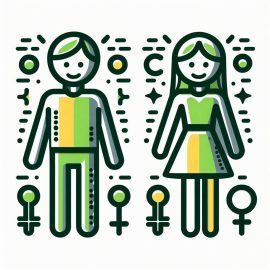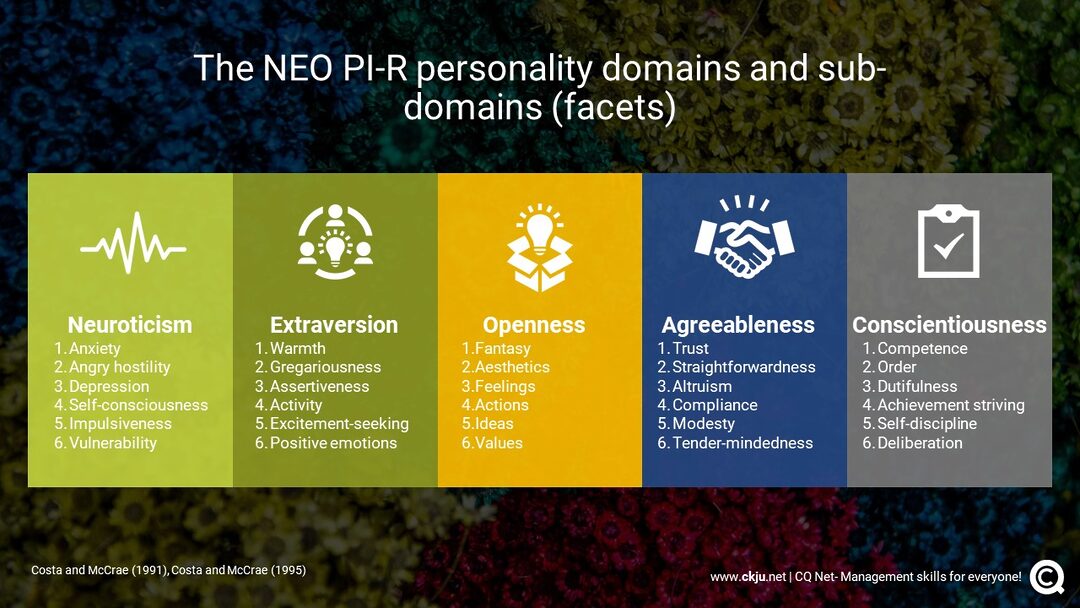Big 5 Personality Theory – Intro

The Big 5 Personality Model is widely used in psychology and has been supported by numerous studies. It is considered a comprehensive and reliable approach to understanding personality. It is based on the trait approach.
Currently, the trait approach is one of the major theoretical approaches in psychological studies of personality. The trait theory of personality suggests that people have certain basic traits. The strength and intensity of those traits account for personality differences.
We each have certain traits that dominate our personality, along with a myriad of traits that can arise in different situations. Also, our traits can change over time and be shaped by our experiences. The combination and interaction of various traits form a personality that is unique to each person.
Basically, theorists and consulting psychologists agree that a trait is a personality characteristic that meets three general criteria: it must be consistent, stable, and vary from person to person. Based on this definition, a trait can be thought of as a relatively stable characteristic that causes individuals to behave in certain ways in certain circumstances.
Better understand your own personality traits, strengths, and areas for improvement
Pass the Big Five Personality Test for Free
Or choose any other inventory that resonates with you from our selection
* We use the International Personality Item Pool (IPIP) for our testing approach. It’s a collection of items managed by the Oregon Research Institute, freely available to the public. This tool helps us assess personality traits, and because it’s open-source, it promotes broad research and practical use.
Big 5 = OCEAN
A five-factor personality model, the BIG 5, is the most validated and widely accepted personality theory held by psychologists today. It represents five core traits that interact to form human personality. While researchers often disagree about the exact labels for each dimension, the following are described most commonly and are known by the acronym OCEAN:
O – Openness (or openness to experience, level of adventure and creativity)
C – Conscientiousness (level of thoughtfulness and structure)
E – Extraversion (level of socialness and emotional expressiveness)
A – Agreeableness (level of cooperation and caring for others)
N – Neuroticism (level of mood stability and emotional resilience)
History and Background

The BIG 5 model resulted from the contributions of many independent researchers. Gordon Allport and Henry Odbert first formed a list of 4,500 terms relating to personality traits in 1936. Their work provided the foundation for other psychologists to begin determining the basic dimensions of personality. In the 1940s, Raymond Cattell and his colleagues used a statistical method of factor analysis to narrow down Allport’s list to 16 traits. However, numerous psychologists examined Cattell’s list and found that it could be further reduced to five traits. Among these psychologists were Donald Fiske, Norman, Smith, Goldberg, and McCrae & Costa (Cherry, 2019).
In particular, Lewis Goldberg advocated heavily for five primary factors of personality. His work was expanded upon by McCrae and Costa, who confirmed the validity of the theory and provided the model used today: openness to experience, conscientiousness, extraversion, agreeableness, and neuroticism.
Reliability of the Big 5 Assessment

Assessments based on the BIG 5 personality tests are very reliable, provided that sufficient research has been carried out and substantiated. It is, to date, the most scientifically validated and reliable psychological model to measure personality. It is used to help predict behaviour as well as personality.
It remains a dependable model that businesses and scientific studies have been able to use consistently over a long period of time. This basic model helps to create new models, which predict workplace behaviour, response to stressful situations and even understanding aspects of recorded social studies.
Trait Measurement
Traditionally, a BIG 5 personality test is taken with a questionnaire and a multiple choice response. For example, these questions will ask how much a person agrees or disagrees that he or she is someone who exemplifies various specific statements, such as:
- “Open to trying new experiences” (for openness to experience).
- “Always thinking about others” (for conscientiousness).
- “The centre of attention at a party” (for extroversion).
- “Trusting of others” (for agreeableness).
- “Anxious about the future all the time” (for neuroticism).
The responses, from “Strongly agree” to “Strongly disagree” (with alternatives in between) will determine to what scale the person may be grouped into different personality traits.
Unlike other trait theories that sort individuals into binary categories (i.e. intravert or extravert), the BIG 5 Personality Model asserts that each personality trait is a spectrum. Therefore, the most of individuals are not on the polar ends of the spectrum but rather somewhere in between.
For instance, when measuring Extraversion, one would not be classified as purely extroverted or introverted. Rather they are placed on a scale determining their level of extraversion. By ranking individuals on each of these traits, it is possible to effectively measure individual differences in personality.
Universality and Stability of the Big 5 Traits
McCrae and his colleagues have found that the big five traits are remarkably universal. One study looked at people from more than 50 different cultures found that the five dimensions could be accurately used to describe personality.
Moreover, the BIG 5 traits remain relatively stable throughout most of one’s lifetime. They are influenced significantly by both genes and the environment. Twin studies have found that the heritability (the amount of variance that can be attributed to genes) of the BIG 5 traits is 40–60%. It is supposed that five core personality traits represent the most important qualities shaping social landscape and predicting life outcomes.

Gender Differences
Certain differences in the Big Five personality traits between genders have been observed. However, these differences are small compared to those between individuals within the same gender. Women reported themselves to be higher in Neuroticism, Agreeableness, Warmth (Extraversion), and Openness to Feelings compared to men. Men reported themselves to be higher in Assertiveness (Extraversion) and Openness to Ideas. More significant gender differences were reported in WEIRD countries. Researchers proposed that the most plausible reason for this finding was attribution processes. Most likely, actions of women in individualistic countries would be more likely to be attributed to her personality. At the same time actions of women in collective countries would be more likely to be attributed to their compliance with gender role norms.
Behavioral Outcomes
Health
Neuroticism seems to be a risk factor for many health problems, including depression, schizophrenia, diabetes, asthma, irritable bowel syndrome, and heart disease. People high in neuroticism are particularly vulnerable to mood disorders such as depression. There is evidence to suggest that conscientiousness is a protective factor against health diseases. People who score high in conscientiousness have been observed to have better health outcomes and longevity. Researchers believe that such is due to conscientious people having regular and well-structured lives. Moreover, they have stronger impulse control to follow diets, treatment plans, etc.
Working Environment
Openness
A candidate with a high openness score would be willing to learn new skills and tools. Presented with more abstract problems, they are more likely to think of abstract solutions and would be focused on tackling new problems that were perhaps previously overlooked. Openness to experience is positively related to individual proactivity but negatively related to team efficiency.
Conscientiousness
Candidates with a high conscientiousness score wouldn’t necessarily be sat at their desk until midnight every evening. They would however be keen to get their work done, meet deadlines and be a self-starter; requiring little hand-holding to get the task done. Someone scoring low on the other hand, would need a lot more focus, time and attention to the task at hand. Conscientiousness is the strongest predictor of all five traits for job performance. A high score of conscientiousness has been shown to relate to high work performance across all dimensions.
Extraversion
The ideal extraversion scores would depend on the role you’re hiring for. Seen by many to be leaders in a team, a high extraversion score would do well in environments where they thrive off interaction with others: sales, marketing & PR all require a level of people-facing skills. More technical job setups where specific focus or a degree of isolation is needed would, however, not be a good fit.
Agreeableness
A candidate who shows high agreeableness would suit a role where personal skills and an ability to be at the service of others are needed. Of course, the opposite would be bad in a strong team environment and cause significant issues in order to work towards a common goal or task.
Neuroticism
Finally, a candidate who exhibits high neuroticism will not be a good choice for a role where there are consistent changes, tasks requiring strong self-starter tendencies or high stress levels. Those with low neuroticism scores will, however, thrive in these kinds of workplace scenarios.
Is 5 a Magic Number?

A common criticism of the Big Five is that each trait is too broad. Although the Big Five is useful in terms of providing a rough overview of personality, more specific traits are required to be of use for predicting outcomes. There is also an argument from psychologists that more than five traits are required to encompass the entirety of personality. Taking this criticism into account, by 1992 Costa and McCrae developed a new model, IPIP NEO Personality Inventory, that included six facets for each of the BIG 5 personality traits, 30 facets in total.
Interesting Facts Related to the Big 5 Traits
Are some personality traits a good fit for almost any job?
The short answer is yes: Conscientiousness is the best predictor of work performance. Someone who shows up on time and does the job responsibly is usually a great employee, and that’s the essence of conscientiousness.
Organizational citizenship behavior (OCB) is doing positive things for the organization beyond a defined job.
People who engage in OCBs are more conscientious and agreeable. Openness to experience is also connected to OCB. Highly open people may see areas that need change and improvement and then take the time to make those changes.
Counterproductive Workplace behavior (CWB) is unethical, illegal, or unwise workplace behaviors such as stealing and bullying.
People low in conscientiousness and low in agreeableness are the most likely to engage in CWB. Narcissism also predicts CWBs, especially when a narcissist thinks the organization is taking advantage of them.
What traits do employers look for?
Most often, employers look for high conscientiousness, high agreeableness, and low neuroticism.
Which personality types make more money?
High conscientiousness and low neuroticism predict higher pay. In other words, emotionally stable people who work hard are going to do well. -Extraverts also make more money, probably be extraverted people are goal oriented and assert themselves. Agreeable people make less money (kind, caring, and humble).
Get personality insights for
customers, partners and employees
Know your target audience better
